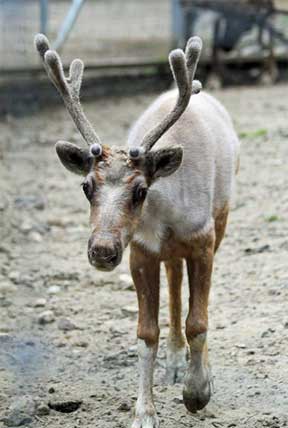Reindeer born at Stone Zoo
Tuesday April 29, 2014
 The staff at Stone Zoo is pleased to announce the birth of a male reindeer, which marks the first birth of this species at the Zoo.
The staff at Stone Zoo is pleased to announce the birth of a male reindeer, which marks the first birth of this species at the Zoo.
The calf, born around 2:40 p.m. on Sunday, April 27, can be seen on exhibit with his mother Holly. His father, Cornelius, also resides at Stone Zoo.
The newborn reindeer, which weighs 15 pounds, received its first well-baby examination yesterday and appeared healthy, bright and alert. As with any new birth, the veterinary and animal management staffs are closely monitoring the mother and baby.
“We are thrilled to share news of this exciting birth,” said John Linehan, Zoo New England President and CEO. “Holly is a protective first-time mother and she is being very attentive to her newborn calf. The baby has been standing and walking, and he is nursing well. Visitors are going to take great delight in watching this baby grow up.”
The gestation period for reindeer is about 7 months. Pregnant reindeer do not shed their antlers until a few days to a week after giving birth. Willow, the other female reindeer that resides at Stone Zoo, shed her antlers earlier this year and her new antlers are already starting to grow. Reindeer are the only species of cervid (member of the deer family) where both males and females have antlers.
The reindeer is one of 36 species of deer in the world. These animals can be found in the arctic tundra, as well as in boreal forests in Norway, Sweden, Finland and Russia. They have been domesticated in Scandinavia for thousands of years. The reindeer has two thick coats – an outer coat and undercoat – that help keep this animal warm in cold temperatures. The two-toed hooves of a reindeer help prevent slips and falls in icy conditions. Reindeer are herbivores and enjoy a diet of leaves, bark, moss and lichen, and they have antlers that are shed and re-grown each year.
Learn more about the reindeer on Stone Zoo's Animal section.
Zoo New England manages Franklin Park Zoo in Boston and Stone Zoo in Stoneham. Both are accredited by the Association of Zoos and Aquariums (AZA). Zoo New England's mission is to inspire people to protect and sustain the natural world for future generations by creating fun and engaging experiences that integrate wildlife and conservation programs, research, and education.

